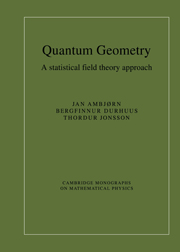1 - Introduction
Published online by Cambridge University Press: 20 October 2009
Summary
The idea of describing the physical world entirely in terms of geometry has a history dating back to Einstein and Klein in the early decades of the century. This approach to physics had early success in general relativity but the appearance of quantum mechanics guided the development of theoretical physics in a different direction for a long time. During the past quarter of a century the programme of Einstein and Klein has seen a renaissance embodied in gauge theories and, more recently, superstring theory. During this time we have also witnessed the happy marriage of statistical mechanics and quantum field theory in the subject of Euclidean quantum field theory, a development which could hardly have taken place without Feynman's path integral formulation of quantization. In this book we shall work almost exclusively in the Euclidean framework.
The unifying theme of the present work is the study of quantum field theories which have a natural representation as functional integrals or, if one prefers, statistical sums, over geometric objects: paths, surfaces and higher-dimensional manifolds. Our philosophy is to work directly with the geometry as far as possible and avoid parametrization and discretizations that break the natural invariances. In this introductory chapter we give an overview of the subject, put it in perspective and discuss its main ideas briefly.
Lagrangian field theories whose action can be expressed entirely in terms of geometrical quantities such as volume and curvature have a special beauty and simplicity.
- Type
- Chapter
- Information
- Quantum GeometryA Statistical Field Theory Approach, pp. 1 - 10Publisher: Cambridge University PressPrint publication year: 1997



